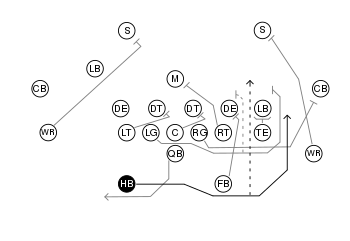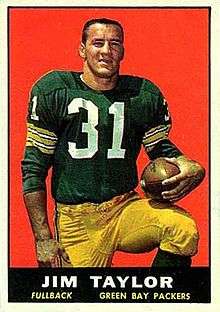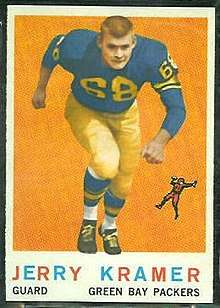Packers sweep
The Packers sweep, also known as the Lombardi sweep, is an American football play popularized by Green Bay Packers coach Vince Lombardi. The Packers sweep is based on the sweep, a football play that involves a back taking a handoff and running parallel to the line of scrimmage before turning upfield behind lead blockers. The play became noteworthy due to its extensive use by the Packers in the 1960s, when the team won five National Football League (NFL) Championships, as well as the first two Super Bowls. Lombardi used the play as the foundation on which the rest of the team's offensive game plan was built. The dominance of the play, as well as the sustained success of the Lombardi's teams in the 1960s, solidified the Packers sweep's reputation as one of the most famous football plays in history.
The sweep
The sweep is a running play in American football where a back, typically the halfback or running back, takes a pitch or handoff from the quarterback and starts running parallel to the line of scrimmage. This allows both the offensive linemen (usually the guards) and the fullback to block defenders before the runner turns upfield.[1] The sweep can be run out of multiple formations and go either left or right of the center. It is characterized as power football[2] and usually gives the runner the choice to follow the blockers ahead of him inside or outside, depending on how the defense reacts.[3] Various options and changes to the sweep have been implemented to create further deception. These include running option pass plays out of the same formation,[4] changing which blockers pull from the line of scrimmage, and running the play towards different areas of the field.[1]
Lombardi era
The development of the Packers sweep began with Vince Lombardi. He played football at Fordham University on a football scholarship,[5] and was part of the "Seven Blocks of Granite", a nickname for the team's offensive line.[6] This was the first time Lombardi witnessed the success of the sweep. Jock Sutherland's University of Pittsburgh teams used the sweep extensively against Lombardi's team in an era when the single-wing formation was used almost universally.[5] In 1939, after graduation, Lombardi began his coaching career as an assistant at St. Cecilia High School in Englewood, New Jersey. He was promoted to head coach and over eight seasons led St. Cecilia's to multiple championships. With a 32-game unbeaten streak, the school had one of the top high school football programs in the nation.[7] Lombardi attended coaching clinics during this time, where he continued to develop a better understanding of the sweep, especially the techniques of pulling offensive linemen and having the ball carriers cut back towards openings in the line.[8] He moved on from high school to college football as an assistant under Earl "Red" Blaik at West Point in 1948.[6] For five seasons Lombardi served as an assistant coach and further developed his coaching abilities. Blaik's emphasis on players executing their job and the military discipline of West Point greatly influenced Lombardi's future coaching style.[8]
Lombardi's first NFL coaching job came in 1954, when he accepted an assistant coaching job (now known as an "offensive coordinator") for the New York Giants.[6][8] It was with the Giants that Lombardi first implemented the principles of the sweep using the T formation. He positioned his lineman with greater space between each other,[9] had offensive tackles pull from the line, and implemented an early variant of zone blocking (blockers are expected to block a "zone" instead of an individual defender); this required the ball carrier to run the football wherever there was space.[8] The phrase "running to daylight" was later coined to describe the freedom the ball carrier had to choose where to run the play.[10] Under his offensive leadership and assisted by his defensive counterpart Tom Landry, Lombardi helped guide the Giants to an NFL Championship in 1956.[11] They appeared again in the 1958 Championship Game losing in overtime to the Baltimore Colts.[8][12] In 1959, Lombardi accepted a head coaching and general manager position with the struggling Green Bay Packers.[6] The Packers had just completed their worst season in team history with a record of 1–10–1.[13] Even though the Packers had not been successful for a number of years, Lombardi inherited a team in which five players would go on to be Pro Football Hall of Famers.[14] He immediately instituted a rigorous training routine, implemented a strict code of conduct, and demanded the team continually strive for perfection in everything they did.[8]

The first play Lombardi put into the playbook after he arrived in Green Bay was the sweep.[8] He moved Paul Hornung to the halfback position permanently (in the past he had been poorly utilized in different back positions) and made him the primary ball-carrier.[15] The Packers sweep, as it became known, was the team's lead play and the foundation on which the rest of the offensive plan was built.[9][16] For the team to succeed, Lombardi drilled them constantly on the play, expecting it to be executed perfectly every time.[17] The play became the epitome of Lombardi's philosophy: a simple, yet fundamentally sound play that was reliant on the entire team working together to move the ball.[8][10] Even though each player had a role to perform, the execution of the center, the pulling guards, and the halfback were essential to the play's success.[16] The center had to cut off the defensive tackle or middle linebacker to prevent the defender from breaking up the play behind the line of scrimmage.[18] This was due to the right guard (when the play was run to the right side of the field), who would vacate this space while pulling to lead the ball carrier. The most difficult block fell on the left guard, who had to pull the whole way across the field to be the lead blocker.[5] The left guard also had to decide, based on how the defense reacted, whether to push the play to the inside or outside of the tight end.[18] The ball carrier, usually the halfback, then decided whether to go inside or outside as well.[1][14] The fullback, tight end, and left tackle also had essential blocks that dictated the success of the play.[16][19]
For nine seasons Lombardi ran the Packers sweep with great success.[20] Even when defenses shifted to try to stop it, Lombardi would either attack other weaknesses or would run variations of the sweep.[21] At times he would change the play to go to the left side, have various blockers not pull, switch the ball carrier or direction of the run, or have option pass plays—each of which could be run out the sweep formation.[10][22] Other coaches in the league had great respect for the Packers sweep, although most acknowledged the success of the play was based on two criteria: great players and perfect execution.[5][23] Throughout his tenure, Lombardi had three offensive linemen (Jim Ringo, Forrest Gregg, and Jerry Kramer), two backs (Hornung and Jim Taylor), and one quarterback (Bart Starr) who were later elected to the Pro Football Hall of Fame.[24] Each of those offensive players was instrumental to the success of the Packers sweep and thus the offense. Ringo, Gregg, Kramer, and Taylor each provided key blocks for Hornung to run the sweep. Starr (who as the quarterback orchestrated the play) and Taylor were essential to variations of the sweep that called for different runners or option pass plays.[10] In addition to the Hall of Famers, Lombardi's teams included other highly decorated players, such as first-team All-Pro Fuzzy Thurston, the left guard who had the most challenging blocking assignment in the sweep.[5][20] Many of these players identified Lombardi's coaching and drive for perfection as important factors behind their accomplishments and the team's success.[5][6][15]
Legacy
At its core, the Packers sweep was basic power running,[3] with a focus on all members of the team precisely executing their responsibilities.[9][16] Lombardi would run the play in practice until its execution was perfect every time (it was common for the team to run the play at the beginning and end of every practice).[17][25] The play became so successful that defenses would shift their entire scheme just to stop the sweep. In response Lombardi would run option plays, variations of the sweep, or attack different parts of the field with different plays.[3][16] This allowed the Packers to control the ball and the time clock, slowly moving the ball down the field and exhausting the defense. The Packers were so confident in the play they would run it repeatedly, sometimes consecutively. On many occasions defenses would know the play was coming and still be unable to stop it.[5]
The Packers of the 1960s were dominant in many respects. In nine seasons at the helm, Lombardi and his sweep led the Packers to five NFL championships, as well as victories in Super Bowl I and II.[20] The team won three straight championships in 1965, 1966, and 1967—only the second team to accomplish this feat (the other being the 1929, 1930, and 1931 Packers).[26] Thirteen Packers who played under Lombardi in the 1960s were later elected to the Pro Football Hall of Fame; Lombardi was elected shortly after his death in 1971.[24] Three of these Packers (Hornung, Starr, and Taylor) who played on the offense won NFL MVP awards in the 1960s.[27][28][29] Much of the Packers' offensive success was based on the threat of running the sweep. Lombardi exploited the dominance of the play to take advantage of defenses and run the offense to his team's strengths.[3] This dominance and continued success has led to the Packers sweep's reputation as one of the most famous football plays in history.[16][25]
References
Citations
- 1 2 3 Gruver 1997, p. 1.
- 1 2 3 4 Gulbrandsen 2011, p. 80.
- ↑ Bell, Jarrett (September 24, 2008). "Odd formations could become latest fad across NFL". Gannett Company. Archived from the original on January 6, 2012. Retrieved July 1, 2018.
- 1 2 3 4 5 6 7 Gruver 1997, p. 2.
- 1 2 3 4 5 "Greatest Coaches in NFL History – 1. Vince Lombardi: Simply the best". ESPN Internet Ventures. June 11, 2013. Archived from the original on July 7, 2018. Retrieved July 7, 2018.
- ↑ O'Connor, Ian (January 23, 2014). "Gospel of St. Vince". ESPN Internet Ventures. Archived from the original on July 7, 2018. Retrieved July 7, 2018.
- 1 2 3 4 5 6 7 8 Gruver 1997, p. 3.
- 1 2 3 Maraniss 1999, p. 222.
- ↑ Sell, Jack (December 31, 1956). "Giants crush Bears in title game, 47–7". Pittsburgh Post-Gazette. p. 12. Archived from the original on May 27, 2016. Retrieved September 26, 2018 – via Google News Archive

- ↑ Sandomir, Richard (December 4, 2008). "The 'Greatest Game' in Collective Memory". The New York Times. Archived from the original on July 7, 2018. Retrieved July 7, 2018.
- ↑ Johnson, Chuck (January 29, 1959). "Packers name Vince Lombardi head coach, general manager". Milwaukee Journal Sentinel. p. 11, part 2. Archived from the original on May 19, 2016. Retrieved September 26, 2018 – via Google News Archive

- 1 2 Fox, Bob (July 25, 2014). "Green Bay Packers: Jerry Kramer Talks About the Power Sweep". Turner Broadcasting System. Archived from the original on July 7, 2018. Retrieved July 1, 2018.
- 1 2 Hendricks, Martin (January 21, 2009). "Hornung set the solid-gold standard". Milwaukee Journal Sentinel. Archived from the original on July 7, 2018. Retrieved July 4, 2018.
- 1 2 3 4 5 6 Christl, Cliff (February 1, 2018). "Jerry Kramer was lineman at forefront of Lombardi's power sweep". Green Bay Packers, Inc. Archived from the original on July 7, 2018. Retrieved July 1, 2018.
- 1 2 Maraniss 1999, p. 225.
- 1 2 Maraniss 1999, p. 223.
- ↑ Maraniss 1999, p. 224.
- 1 2 3 Weber, Bruce (December 15, 2014). "Fuzzy Thurston, Big Broom in the Packers' Great Sweep Play, Dies at 80". The New York Times. Archived from the original on July 7, 2018. Retrieved July 1, 2018.
- ↑ Lombardi & Heinz 1963, p. 85.
- ↑ Lombardi & Heinz 1963, p. 131.
- ↑ Lombardi & Heinz 1963, p. 14.
- 1 2 "Pro Football Hall of Famers by Team". Pro Football Hall of Fame. Archived from the original on October 15, 2015. Retrieved July 1, 2018.
- 1 2 Gruver 1997, p. 4.
- ↑ "NFL Champions". Pro Football Hall of Fame. Archived from the original on June 20, 2018. Retrieved July 4, 2018.
- ↑ "Hornung Is 'Most Valuable'". Star Tribune. Associated Press. December 21, 1961. p. 21. Archived from the original on July 8, 2018. Retrieved July 3, 2018 – via Newspapers.com

- ↑ Hand, Jack (December 15, 1966). "Bart Starr Most Valuable Player". The Morning Record. Associated Press. p. 9. Archived from the original on October 1, 2018. Retrieved July 3, 2018 – via Newspapers.com

- ↑ "Jim Taylor Player of Year and Allie Sherman Coach of Year in NFL Voting". The Evening Times. Associated Press. December 13, 1962. p. 14. Archived from the original on July 8, 2018. Retrieved July 3, 2018 – via Newspapers.com

Bibliography
- Dunnavant, Keith (2012). Bart Starr: America's Quarterback and the Rise of the National Football League. New York, NY: St. Martin's Press. ISBN 978-0-312-36349-9.
- Gruver, Ed (1997). "The Lombardi Sweep" (PDF). The Coffin Corner. 19 (5). Archived (PDF) from the original on July 7, 2018. Retrieved October 1, 2018 – via Professional Football Researchers Association

- Gulbrandsen, Don (2011). Green Bay Packers: The Complete Illustrated History – Third Edition. MVP Books. ISBN 978-0760342220. Archived from the original on October 7, 2018. Retrieved September 27, 2018 – via Google Books

- Lombardi, Vince; Heinz, W. C. (1963). Run to Daylight!. New York, NY: Simon & Schuster. ISBN 978-1-4767-6717-8.
- Maraniss, David (1999). When Pride Still Mattered: A Life of Vince Lombardi. Simon & Schuster. ISBN 978-0-618-90499-0.


.jpg)
